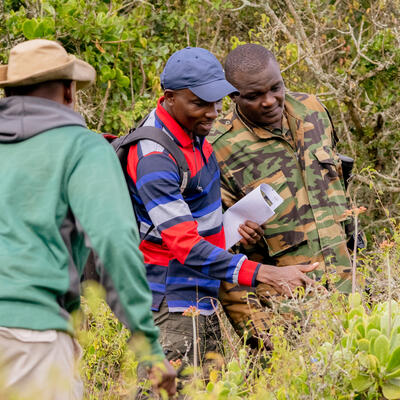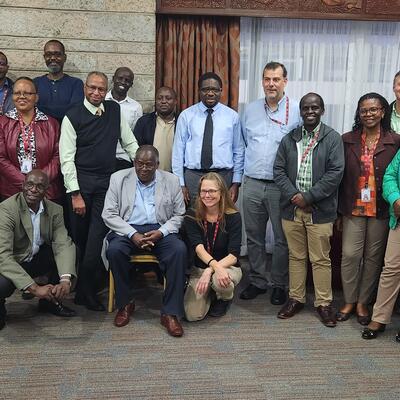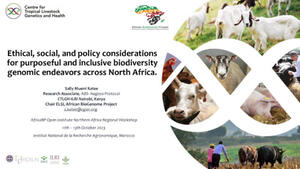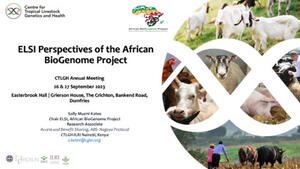
Development and application of decision-support tools to conserve and sustainably use genetic diversity in indigenous livestock and wild relatives
The most significant threats to the diversity of farm animal genetic resources (FAnGR) are crossbreeding and breed replacement. The growing use of exotic breeds has led to the extinction or severe erosion of genetic diversity in traditional breeds, despite their adaptation to local environments. Lack of awareness about the importance of maintaining indigenous diversity, and the production potential of these traditional breeds, are the principal reasons behind these trends. Often national policies that do not adequately identify the need for or address the conservation of FAnGR, exacerbate the negative effects on genetic diversity. The perception persists that specialized exotic, mainly European origin, breeds (those that thrive in temperate conditions) are the best option for increased production and income. These perceptions are based on market analyses that are distorted by, e.g., government and donor subsidies, maintenance costs tied to exotic breeds without adaptive capabilities and lack of recognition of the often multi-functional roles of indigenous FAnGR. In developing countries, the roles of indigenous livestock often include the provision of traction and manure, and as sources of savings, insurance, cyclical buffering, accumulation and diversification, and serving socio-cultural roles (e.g. dowry payments and/or slaughter during special ceremonies). These important services are rarely valued in livestock assessments, leading to distorted government policies and interventions that fail to properly consider the impact of ‘new’ agricultural practices (e.g. crossbreeding or breed replacement) on farmer livelihoods and indigenous FAnGR. In the same way market access and infrastructures are weak and inequitable. This is especially difficult for poor farmers in remote villages, where the majority of indigenous FAnGR are kept. These farmers then use their livestock for subsistence purposes and only occasionally sell ‘surplus off take’, often at prices dictated by market agents.
Major barriers to addressing these challenges are the lack of an appropriate policy framework for the sustainable management of FAnGR and the inadequate knowledge of the value of indigenous breeds. The latter varies amongst the stakeholder groups, with farmers and breeders’ associations holding the most knowledge and government officials the least. Links between and among these groups are weak or non-existent. Basic information about valuable indigenous breeds and representative animals is needed, as is the capacity to prioritize, monitor and manage them at both scientific and farm operational levels. Stakeholder groups need to be empowered with knowledge and conducive operational environments in which they can make decisions that work best for them.
Representatives of these scenarios are Bangladesh, Pakistan, Sri Lanka and Vietnam, the partner countries in this project. Their agriculture contributes 20 to 26% of GDP of which livestock contributes approximately 15 to 20% in terms of income, insurance, food (meat, milk, eggs, etc.), hides/skin, traction and manure. Smallholder farmers, who are dependent on indigenous breeds, raise a large majority of the livestock. These FAnGR have evolved in diverse tropical environments and possess valuable traits such as disease resistance, adaptation to harsh environments, including heat tolerance and ability to utilize poor quality feeds, attributes essential for achieving sustainable agriculture in low-input production systems. However, it is still largely unknown which breeds hold significant genetic diversity or specific genes that should be targeted for conservation and/or incorporation into breeding programs. Similarly, wild relatives as progenitors of FAnGR represent an enormous putative reservoir of diversity and adaptation that is still largely unrecognized and under-utilized. Meantime crossbreeding with exotic breeds is increasing and indigenous breeds are being lost and/or being exposed to increasing risk of loss.
Objectives/goals
The development objective of the project is the Conservation of indigenous livestock for future generations and their increased contribution to livelihoods through enhanced use. The immediate objective of the project is to develop and to make available effective tools to support decision making for the conservation and sustainable use of indigenous FAnGR and their wild relatives in developing countries.
Project location
Bangladesh, Pakistan, Sri Lanka, Vietnam
Expected outputs
- Enhanced conservation of FAnGR diversity using decision support tools
- Increased capacity and enhanced knowledge to use decision support tools for conservation of livestock diversity at national and global levels

















